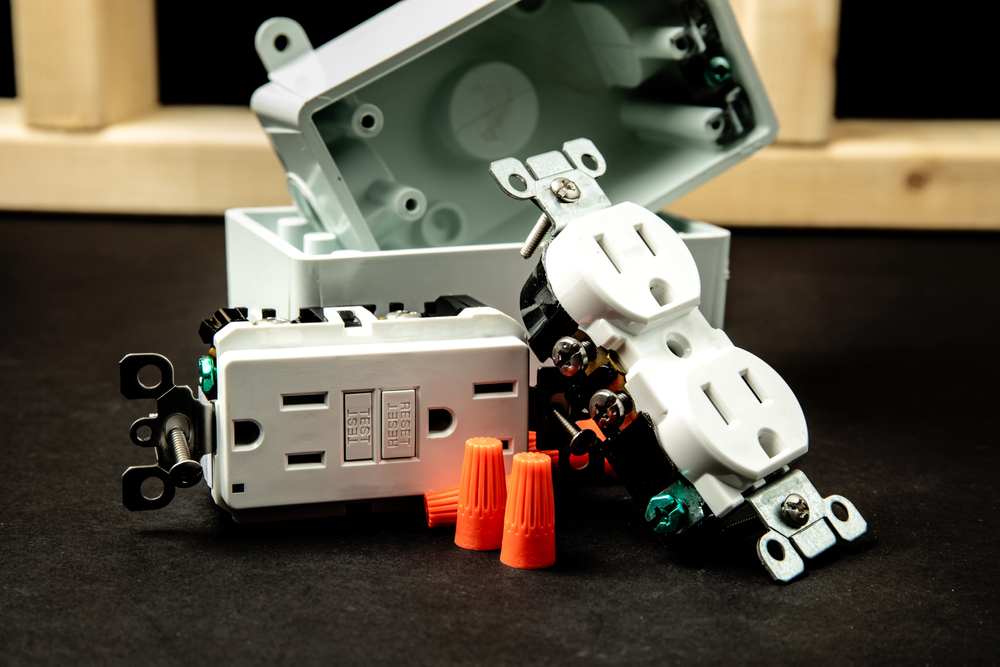
When designing a home electric system, safety is of the utmost importance. Electric failures are responsible for over 50,000 residential fires per year and can pose a severe health hazard. One of the most important aspects of electrical safety is knowing the difference between AFCI and GFCI outlets. These two types of outlets are practically standard in electrical work nowadays, but homeowners might not know much about them.
In the interest of electrical safety, the team at Maitz Home Services is here to talk about the main difference between AFCI vs. GFCI outlets. We will also cover some tips and pointers for proper outlet installation and use.
Contact Maitz Home Services today for all your electrical needs.
What Are AFCI Outlets?
Arc fault circuit interrupter breakers are a type of device that continuously monitors electrical current in an outlet. If the AFCI outlet detects any arcing electricity (electricity jumping from one place in a circuit to another), it shuts off the electrical current, protecting the outlet and any electrical cables from damage.
Most modern housing construction codes require AFCI circuit breakers in key parts of the house, such as kitchens, bedrooms, and living rooms. Your insurance company may offer a discount on your homeowners’ policy if you install AFCI breakers. If your home was built before 2000, we highly recommend updating your electrical system to include AFCI breakers.
What About GFCI Outlets?
Ground fault circuit interrupter protectors are outlets designed to ground electrical circuits. Electricity follows the path of least resistance, so electricity might accidentally travel through the user into the ground. GFCI outlets monitor total amperage and shut the circuit off when it detects a drop in current.
GFCI outlets are the common three-pronged outlets with a test and reset button. The third prong connects to the main grounding wire, which redirects electricity when a ground fault occurs. You may also have a GFCI circuit breaker switch in your electrical panel. GFCI breakers in electrical panels are for circuits that don’t have an external outlet.
Key Differences Between AFCI and GFCI
The main difference between AFCI and GFCI outlets is the kind of electrical fault they protect against. AFCI outlets protect against electrical arcing, while GFCI outlets protect against ground faults. Regardless of the differences, both AFCI and GFCI outlets are incredibly important for electrical safety, and you should have both types of outlets and breakers at key points of your electrical system. Neither type of outlet is better than the other as they serve different purposes.

Where to Install AFCI and GFCI Outlets
According to the 2022 National Electric Code, new home constructions must include AFCI breakers in:
- Finished basements
- Living or common rooms
- Closets and hallways
- Kitchens
- Laundry rooms
- Bedrooms
Basically, any room that needs electricity readily available should have an AFCI breaker in the system. Similarly, the National Electrical Code (NEC) requires GFCI outlets to be in the following rooms of the house.
- Garages
- Bathrooms
- Outdoor outlets
- Kitchens (countertops and dishwasher outlets)
- Laundry rooms
The NEC also requires that GFCI outlets be installed within six feet of sinks, bathrooms, and showers. If you are not sure about where to install AFCI breakers or GFCI outlets, you can call an expert electrician like the team at Maitz Home Services for guidance and installation.
Installation and Maintenance Tips
Electricity can be extremely dangerous, so you need to approach any DIY electrical work with the proper safety precautions. Below are some tips to reduce the risk of shocks, accidents, and fires when installing electrical equipment or performing electrical maintenance:
- You can replace already existing outlets and faceplates on your own without too much trouble, but you should always hire a professional to install a new outlet or run a new electrical circuit. Electrical wiring can be extremely dangerous if you don’t know what you are doing.
- Get in the habit of testing AFCI breakers and GFCI outlets at least once a month. You can test an outlet with a simple voltmeter.
- If one of your outlets or breakers is broken, replace it as quickly as possible. Damaged circuit breakers and outlets can’t dissipate electricity, which can lead to fires and other electrical damage.
- Always follow the manufacturer’s instructions when dealing with breakers and outlets. Also, only choose outlets that have passed independent third-party electrical testing.
Protect and Power Your Home With Maitz Electrical Services
Knowing the differences between AFCI and GFCI outlets is crucial for proper fire and electrical safety and staying up to code. The experts at Maitz Home Services are here for all your questions about safe outlet installation and utilization.
For over 50 years, Maitz Home Services has been the premier provider of electrical services in Allentown, PA. Contact us at (484) 795-0018 or send us a message to schedule same-day electrical service.

